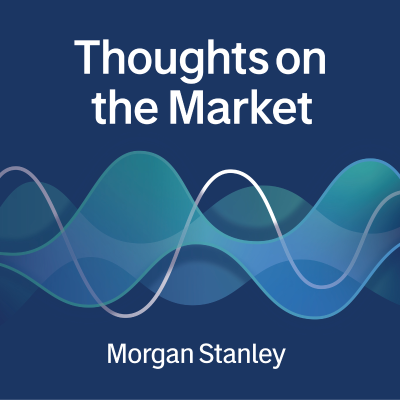
Thoughts on the Market
Podcast de Morgan Stanley
Empieza 7 días de prueba
$99 / mes después de la prueba.Cancela cuando quieras.

Más de 1 millón de oyentes
Podimo te va a encantar, y no estás solo/a
Valorado con 4,7 en la App Store
Acerca de Thoughts on the Market
Short, thoughtful and regular takes on recent events in the markets from a variety of perspectives and voices within Morgan Stanley.
Todos los episodios
1481 episodiosOur Chief Asia Economist Chetan Ahya discusses how youth unemployment will impact future growth and stability across China, India, and Indonesia. Read more insights [https://www.morganstanley.com/insights?cid=mg-SM_CORP-insights-17607] from Morgan Stanley. ----- Transcript ----- Welcome to Thoughts on the Market. I’m Chetan Ahya, Morgan Stanley’s Chief Asia Economist. Today – Asia’s young workforce is facing a significant challenge. How a soft labor market will shape everything from consumer demand to social stability and long-term growth. It’s Tuesday, October 14th, at 2pm in Hong Kong. Across Asia, a concerning trend is emerging. The region’s younger generations face mounting challenges in the job market. Asia’s youth unemployment averages 16 percent, which is much higher than the U.S. rate of 10.5 percent. Youth unemployment rates are running two to three times higher than headline unemployment rates. The underlying situation is even weaker than what is represented by [the] unemployment rate. And within Asia, the challenge is most acute in China, India, and Indonesia, the three most populous economies. Youth unemployment rates for these three economies are running close to double, as compared to other economies in Asia. Now let’s take a closer look at China. The urban youth unemployment rate, i.e. for 16–24-year-olds, has steadily increased since 2019. What’s driving this rise in unemployment? A mismatch in labor demand and supply. The number of university graduates surged 40 percent over the last five years to close to 12 million. But economy-wide employment has declined by 20 million over the same period. Entry-level wages are sluggish, and automation plus subdued services growth mean fewer opportunities for newer entrants. Turning to India, their unemployment rate is the highest in the region at 17.6 percent. Employment creation has been subdued. And on top of it, India also faces another issue: underemployment. Post-COVID, primary sector – i.e. farming and mining – employment rose by 50 million, reaching a 17-year high. Note that these jobs are relatively low productivity jobs. And this is explained by the fact that [the] primary sector now accounts for less than 20 percent of GDP but it employs about 40 percent of the workforce. That’s a sign of COVID-induced underemployment. How fast must growth be to tackle the unemployment challenge? In our base case, India's GDP will grow at an average of 6.5 percent over the coming decade – and this will mean that India will be one of the fastest-growing economies globally. But this pace of growth will not be sufficient to generate enough jobs. To keep [the] unemployment rate stable, India needs an average GDP growth of close to 7.5 percent; and to address underemployment, the required run rate in GDP growth must be even higher at 12 percent. Shifting to Indonesia, its youth unemployment rate is the second highest in the region. Moreover, close to 60 percent of jobs are in the informal sector. And many of these jobs pay below minimum wage. Similar to India, both these trends signal underemployment. The key reason behind this challenge is weak investment growth. Indonesia's investment-to-GDP ratio has dropped meaningfully over the last five years. So, what’s the way forward? For China, shifting towards consumption and services could reduce labor market mismatches. And for India and Indonesia, boosting investment is key. India in particular needs much stronger growth in its industrial and exports sectors. If reforms fall short, policy makers may need to fall back on increasing social welfare spending to manage social stability risks. Thanks for listening. If you enjoy the show, please leave us a review wherever you listen and share Thoughts on the Market with a friend or colleague today.
Morgan Stanley analysts Betsy Graseck and Michael Cyprys discuss what’s driving unprecedented consolidation for asset and wealth management firms. Read more insights [https://www.morganstanley.com/insights?cid=mg-SM_CORP-insights-17607] from Morgan Stanley. ----- Transcript ----- Betsy Graseck: Welcome to Thoughts on the Market. I'm Betsy Graseck, Morgan Stanley's U.S. Large Cap Banks Analyst and Global Head of Banks and Diversified Finance Research. Michael Cyprys: And I'm Mike Cyprys, Head of U.S. Brokers, Asset Managers and Exchanges Research. Betsy Graseck: The asset management and wealth management industries are on the cusp of major consolidation. We're going to unpack today what's driving the race for scale and what it means for investors and the industries at large. It’s Monday, October 13th at 4pm in New York. Mike, before we dive into the setup for M&A, I did want to get out here on the table. What's your outlook for the asset management industry? Michael Cyprys: Sure. So, asset management today is, call it, $135 trillion industry, in terms of assets under management that are managed for a fee. We expect it to grow at about an 8 percent clip annually over the next five years. And that's driven by faster growth in private markets, solutions and passive strategies, while we expect to see slower growth in the core active arena. Two key drivers of growth there. First private markets. We expect to see rising investor allocations from both institutional investors, but also more importantly from retail investors that remain early days in accessing the asset class. So, as we look out in the coming years, we do expect this democratization of private markets to play out, and we see that being helped by product innovation, investor education and technology advances that are all helping unlock access. Second growth driver is solutions. And I think you're looking at me a little dazed on what's solutions. And by that we really mean products and strategies that are addressing demographic challenges around aging populations. So, think about that as solutions that provide for retirement income, as well as those that offer tax efficient solutions. So, think about that as model portfolios, as well as sub-advisory mandates. We also expect to see growth in outsourced Chief Investment Officer, OCIO mandates and broadly retirement focused products. So that's the asset management industry in terms of our outlook. Betsy, what's your outlook for the growth in the wealth management industry? Betsy Graseck: Well, somewhat similar, but a little bit slower – off of a larger base. What does that mean? So, we are looking for global growth in wealth management of 5.5 percent CAGR, and that is off of a base of [$]301 trillion, which is intriguing, right? Because that's larger than the [$]135 trillion you mentioned for asset management. So, in wealth, we were expecting [$]301 trillion in 2024 grows to [$]393 trillion in 2029. And within the wealth industry, what we see as the driver for incremental opportunities here is both in the ultra high net worth segment as well as the affluent segments, as client needs evolve and technology delivers improving efficiencies. And I think one of the interesting things here – as we think about the look forward from industry perspective – is the fact that both asset management and wealth management industries have been very fragmented for a very long time, especially relative to other financial industries. I think one reason is that they need less capital to operate successfully. But Mike, back to the asset management industry, specifically – deal activity seems to be inching up. What are you attributing this increase in M&A to? Michael Cyprys: Yeah, so we do see M&A picking up, and we expect that to continue over the next couple of years. A number of reasons for that. First growth is becoming a bit more scarce, with clients working with fewer partners. And over the next five years, we expect the number of available slots to continue to decline upwards of a third, which concentrates growth opportunities. Betsy Graseck: Wait, wait, wait. Upwards of a third. And number of slots. When you say number of slots, you're talking about it from the asset manager client perspective… Michael Cyprys: Correct. From the asset owner standpoint or intermediary standpoint. Betsy Graseck: They're looking to consolidate their providers? Michael Cyprys: Correct. Betsy Graseck: Okay. Michael Cyprys: They're looking to work with fewer asset managers. Betsy Graseck: Mm-hmm. Michael Cyprys: At the same time, the winners are taking more share, right? So, our work shows that the largest firms are disproportionately capturing a larger share of net new money as they leveraged their scale to reinvest in capabilities as well as in relationships. And also, I'd point to the fact that we have seen a pickup in deal activity already. And we think that's going to lead more firms to consider strategic activity themselves, as they think and rethink what constitutes scale. And we think that that bar is rising… Betsy Graseck: Mm. Michael Cyprys: And firms are thinking about how to compete effectively as the landscape evolves. And look, this is all in the context of already a lot of challenges and changes happening as you think about evolving client needs. The rising cost of doing business, whether it's investing for growth or even harnessing AI, and that's all pressuring profitability. We think this is particularly a challenge for those mid-size money managers that are multi-asset, multi-liquid and global. Those with, call it, [$]0.5 trillion to [$]2 trillion in size, making them more likely to pursue consolidation, opportunities to bolster their capabilities and scale while also generating cost efficiencies. Betsy Graseck: So now looking forward, what type of deals do you expect and how does it differ from past years? Michael Cyprys: Sure. So, a few things are different than past years. First is that the deal activity is encompassing many forms of partnership. And we think that this experimentation around partnership will only accelerate. That allows, for example, for private market managers to access retail distribution without owning the end infrastructure and the last mile to the customer. It also allows traditional managers to provide their retail customers with access to high quality private market strategies from well-known and branded firms. Second is we see a broadening out of the types of acquisitions themselves when we talk about M&A, right? So, three types of deals. First are deals within the same vertical or intersector. So, think about this as an asset manager buying another asset manager to acquire capabilities, to gain cost synergies or bolster distribution. Second type of deals that we're seeing are ones that expand beyond one's own vertical. So intersector deals. So, asset management combining with wealth or insurance, for example, where firms would seek to own a larger, greater portion of the overall value chain. And so, these firms are getting closer to that end client. For example, an asset manager getting closer to that end customer. And the third type being financial sponsor deals where a sponsor is investing either as an in an asset or a wealth manager. Now you didn't ask me around the historical outcomes of M&A. But I would say that the historical outcomes have been mixed in the asset management space. But here we think that the opportunity ahead is so bright that we think firms will find ways to navigate and pursue strategic activity. But it does require addressing some of the culture and integration challenges that have plagued some of the deals in the past. Betsy Graseck: Okay. Michael Cyprys: So, Betsy, what do you see as the key drivers of consolidation in wealth management? Betsy Graseck: There's several. From the wealth manager side, number one is an aging population of advisor and advisor-owners, and the need to address succession and how to best serve their clients when passing on their book of business. So, we've got succession issues as the number one driver. But additionally, the need for scale is clearly getting higher and higher – given the costs of IT infrastructure rising, the needs to be able to leverage AI effectively and to manage your cyber risk effectively. These are just some of the drivers of desire to merge from the wealth manager perspective. Second. We have an increasing buying pool. If you just look at the large cap banks, for example. Significant amount of excess capital. Could we see some of that excess capital be put to work in the wealth management industry? To me, that would make sense. Why? Because wealth management is one of the best, if not the best financial institution service for shareholders. It is a high ROE business. It also is a business that commands a high multiple in the stock market. So, we would not be surprised to see activity there over the course of the next several years. So, Mike, thanks for joining me on the show today. Michael Cyprys: Thanks, Betsy. Always a pleasure. Betsy Graseck: And to our listeners, thanks for listening. If you enjoy Thoughts on the Market, please leave us a review wherever you listen and share the podcast with a friend or colleague today.
Our U.S. Thematic and Equity Strategist Michelle Weaver discusses how the largest intergenerational wealth transfer in history could reshape saving, spending and investment behavior across America. Read more insights [https://www.morganstanley.com/insights?cid=mg-SM_CORP-insights-17607] from Morgan Stanley. ----- Transcript ----- Michelle Weaver: Welcome to Thoughts on the Market. I'm Michelle Weaver, Morgan Stanley's U.S. Thematic and Equity Strategist. Today, a powerful force reshaping the financial lives of millions of Americans: inheritance. It's Friday, October 10th at 10am in New York. Americans are living longer and they're passing on their wealth later. Longevity is one of Morgan Stanley Research's four key themes, and this is an interesting element of longevity. As baby boomers age, they're expected to transfer their wealth to Gen X, millennials and Gen Z to the tune of tens or even hundreds of trillions of U.S. dollars. Estimates vary widely, but the amounts are unprecedented. And so, inheritance isn't just a family milestone; it's becoming an important cornerstone of financial planning and longevity. And understanding who's receiving, expecting, and using their inheritances is key to forecasting how Americans save, spend, and invest. According to our latest AlphaWise survey, 17 percent of U.S. consumers have received an inheritance, and another 14 percent expect to receive one in the future. Younger Americans are especially optimistic. Their expectations split evenly between those anticipating an inheritance within the next 10 years and those expecting it further out. But here's the kicker; income plays a huge role. Only 17 percent of lower income consumers report receiving or expecting an inheritance, but that number jumps to 43 percent among higher income households highlighting a clear wealth divide. What about the size of the inheritance? In our survey, those who received or expect to receive an inheritance fall broadly into three categories. About half reported amounts under $100,000 dollars. For about a third, that amount rose to under $500,000. And then meanwhile, 10 per cent reported an inheritance of half a million dollars or more. Younger consumers tend to report smaller amounts, while inheritance size rises with income. One important thing to remember about our survey though, is it looks more at the average person. We are missing some of those very high net worth demographics in there where I would expect inheritance to rise much higher than half a million. And so, when we think about this, how will recipients use this wealth? That's a really important question. The majority, about 60 percent, say they have or will put their inheritance towards savings, retirement, or investments. About a third say they'll use it for housing or paying down debt. Day-to-day consumption, travel, education and even starting a business or giving to charity also featured in the survey responses – but to a lesser extent. The financial impact of inheritance is significant: 46 percent of recipients say it makes them feel more financially secure; 40 percent cite improvements in savings; and 22 percent associate it with increased spending. Some even report retiring earlier or lightening their workloads. Inheritance trends are shaping consumer behavior and have the power to influence spending patterns across industries. To sum it up, inheritance isn't just a family matter, it's a market mover. Thanks for listening. If you enjoy the show, please leave us a review wherever you listen, and share Thoughts on the Market with a friend or colleague today.
Diving into the history of Morgan Stanley’s first bond deal, our Head of Corporate Credit Research Andrew Sheets explains the value of high-quality corporate bonds. Read more insights [https://www.morganstanley.com/insights?cid=mg-SM_CORP-insights-17607] from Morgan Stanley. ----- Transcript ----- Andrew Sheets: Welcome to Thoughts on the Market. I'm Andrew Sheets, Head of Corporate Credit Research at Morgan Stanley. Today, a look at the first bond that Morgan Stanley helped issue 90 years ago and what it might tell us about market uncertainty. It's Thursday, October 9th at 4pm in London. In times of uncertainty, it's common to turn to history. And this we think also applies to financial markets. The Great Depression began roughly 95 years ago. Of its many causes, one was that the same banks that were shepherding customer deposits were also involved in much riskier and more volatile financial market activity. And so, when the stock market crashed, falling over 40 percent in 1929, and ultimately 86 percent from a peak to a trough in 1932, unsuspecting depositors often found their banks overwhelmed by this market maelstrom. The Roosevelt administration took office in March of 1933 and set about trying to pick up the pieces. Many core aspects that we associate with modern financial life from FDIC insurance to social security to the somewhat unique American 30-year mortgage rose directly out of policies from this administration and the financial ashes of this period. There was also quite understandably, a desire to make banking safer. And so the Glass Steagall Act mandated that banks had a choice. They could either do the traditional deposit taking and lending, or they could be active in financial market trading and underwriting. In response to these new separations, Morgan Stanley was founded 90 years ago in 1935 to do the latter. It was a very uncertain time. The U.S. economy was starting to recover under President Roosevelt's New Deal policies, but unemployment was still over 17 percent. Europe's economy was struggling, and the start of the Second World War would be only four years away. The S&P Composite Equity Index, which currently sits at a level of around 6,700, was at 12. It was into this world that Morgan Stanley brought its first bond deal, a 30-year corporate bond for a AA rated U.S. utility. And so, listeners, what do you think that that sort of bond yielded all those years ago? Luckily for us, the good people at the Federal Reserve Bank of St. Louis digitized a vast array of old financial newspapers. And so, we can see what the original bond yielded in the announcement. The first bond, Morgan Stanley helped issue with a 30-year maturity and a AA rating had a yield of just 3.55 percent. That was just 70 basis points over what a comparable U.S. treasury bond offered at the time. Anniversaries are nice to celebrate, but we think this example has some lessons for the modern day. Above anything, it's a clear data point that even in very uncertain economic times, high quality corporate bonds can trade at very low spreads – much lower than one might intuitively expect. Indeed, the extra spread over government bonds that investors required for a 30-year AA rated utility bond 90 years ago, in the immediate aftermath of the Great Depression is almost exactly the same as today. It's one more reason why we think we have to be quite judicious about turning too negative on corporate credit too early, even if the headline spreads look low. Thank you as always for your time. If you find Thoughts on the Market useful, let us know by leaving a review wherever you listen. And also, please tell a friend or colleague about us today.
An extended U.S. government shutdown raises the risk for weaker growth potential. Our Global Head of Fixed Income Research and Public Policy Strategy Michael Zezas suggests key checkpoints that investors should keep in mind. Read more insights [https://www.morganstanley.com/insights?cid=mg-SM_CORP-insights-17607] from Morgan Stanley. ----- Transcript ----- Welcome to Thoughts on the Market. I'm Michael Zezas, Global Head of Fixed Income Research and Public Policy Strategy. Today: Three checkpoints we’re watching for as the U.S. government shutdown continues. It’s Wednesday, October 8th at 10:30am in New York. The federal government shutdown in the United States has crossed the one week mark. But if you’re watching the markets, you might be surprised at how calm everything seems. Stocks are steady. Bond yields haven’t moved much, and volatility’s low. It’s more or less the scenario my colleague Ariana and I had talked about in anticipation of the impasse in Washington. We’d noted the potential for uncertainty for investors and market reaction depending on how long the shutdown would last. So that raises a big question: what, if anything, about this government shutdown could shake investor confidence and start moving markets? The question is worth considering. Prediction markets now suggest the most likely outcome is that the government shutdown will not end for at least another week. And as we’ve seen in past shutdowns, the longer it drags on, the more likely it is to matter. That’s because risks to the economic outlook start to accumulate, and investors eventually have to start pricing in a weaker growth outlook. There’s a few checkpoints we’re watching for – for when investors might start feeling this way. First, the missed paycheck for furloughed federal workers. The first instance of this comes in a few days. Less pay naturally means less spending. Studies suggest that spending among affected workers can drop by two to four percent during a shutdown. That’s not huge for GDP at first; but it’s a sign the shutdown is having effects beyond Washington, DC. Second, this time might be different because of potential layoffs. The administration has hinted that agencies could move to permanently cut staff — something we haven’t seen before. Unions have already said they’d challenge that in court. But if those actions start, or even if legal uncertainty grows around them, it could raise the economic stakes. Third, we’re watching for real disruptions to economic activity resulting from the shutdown. The last shutdown ended when air traffic in New York was curtailed due to a shortage of air traffic controllers. We’re already seeing substantial air traffic delays across the country. More substantial delays or ground halts obviously impede economic activity related to travel. And if such actions don’t coincide with signals from DC of progress in negotiating a bill to reopen the government, investors’ concern could grow. So here’s the bottom line: markets may be right to stay calm — for now. But the longer this shutdown lasts, the more likely one of these pressure points pushes investors to rethink their optimism. Thanks for listening. If you enjoy Thoughts on the Market, please leave us a review and tell your friends about the podcast. We want everyone to listen.

Más de 1 millón de oyentes
Podimo te va a encantar, y no estás solo/a
Valorado con 4,7 en la App Store
Empieza 7 días de prueba
$99 / mes después de la prueba.Cancela cuando quieras.
Podcasts exclusivos
Sin anuncios
Podcast gratuitos
Audiolibros
20 horas / mes























